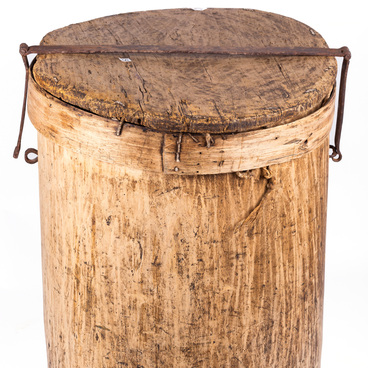The traditional Chuvash women’s outfit includes a unique waist adornment called a sara, or a sari. The museum’s collection contains a relatively modern Chuvash waist adornment with a red weaving warp that was made in the 20th century. Usually, saras were embroidered with woolen and silk threads, and decorated with stripes. Often the appearance of the sara was enriched by a long fringe, and the ornamental patterns could symbolize Chuvash folk ideas about how the world is structured. Stylized images of trees, flowers, and leaves were also used. Often they could be embroidered with colored, interlocking punch needle embroidery. Coarse, homespun fabric was used as the warp weaving.
In the 19th century, new factory-made fabrics and materials, as well as small, handicraft decorative elements from Tatar and Russian artisans, began to be introduced into the production process for Chuvash waist adornments. Starting at the end of that same century, something that began to be considered especially refined was embroidery on sara patterns using thinner cotton fabrics and red silk. At the same time, the motifs in the patterns were very diverse: oblique crosses, small, eight-pointed stars, and numerous variations of rhombuses.
All saras have a two-piece design, and the ends of the belt clearly indicate its origin. Both embroidered halves are connected only at the sides, and are fastened together just at four points, slightly overlapping. Saras worn by Chuvash people in different regions are distinguished by their elongated proportions, a small area of circular, red calico trimming, and the use of different colors.
Chuvash women’s decorations contained not only the folkloric concepts of beauty that had developed over the millennia, but also traces of an archaic worldview. Chuvash decorations are set apart by its fairly complex forms, and that is why it is labor-intensive to produce. Besides that, quite rare and expensive materials were used to produce these decorations. Additional materials to help produce Chuvash decorations were the byproducts of animal husbandry and agriculture: rawhide and crafted leather, thick canvas, felt, cloth called tala, and horsehair called khelekh. It is interesting that the Chuvash did not use birch bark, bast, wood, fur, down, or bird feathers for decorative purposes. At least as of today this kind of ethnographic evidence does not exist.
In the 19th century, new factory-made fabrics and materials, as well as small, handicraft decorative elements from Tatar and Russian artisans, began to be introduced into the production process for Chuvash waist adornments. Starting at the end of that same century, something that began to be considered especially refined was embroidery on sara patterns using thinner cotton fabrics and red silk. At the same time, the motifs in the patterns were very diverse: oblique crosses, small, eight-pointed stars, and numerous variations of rhombuses.
All saras have a two-piece design, and the ends of the belt clearly indicate its origin. Both embroidered halves are connected only at the sides, and are fastened together just at four points, slightly overlapping. Saras worn by Chuvash people in different regions are distinguished by their elongated proportions, a small area of circular, red calico trimming, and the use of different colors.
Chuvash women’s decorations contained not only the folkloric concepts of beauty that had developed over the millennia, but also traces of an archaic worldview. Chuvash decorations are set apart by its fairly complex forms, and that is why it is labor-intensive to produce. Besides that, quite rare and expensive materials were used to produce these decorations. Additional materials to help produce Chuvash decorations were the byproducts of animal husbandry and agriculture: rawhide and crafted leather, thick canvas, felt, cloth called tala, and horsehair called khelekh. It is interesting that the Chuvash did not use birch bark, bast, wood, fur, down, or bird feathers for decorative purposes. At least as of today this kind of ethnographic evidence does not exist.



